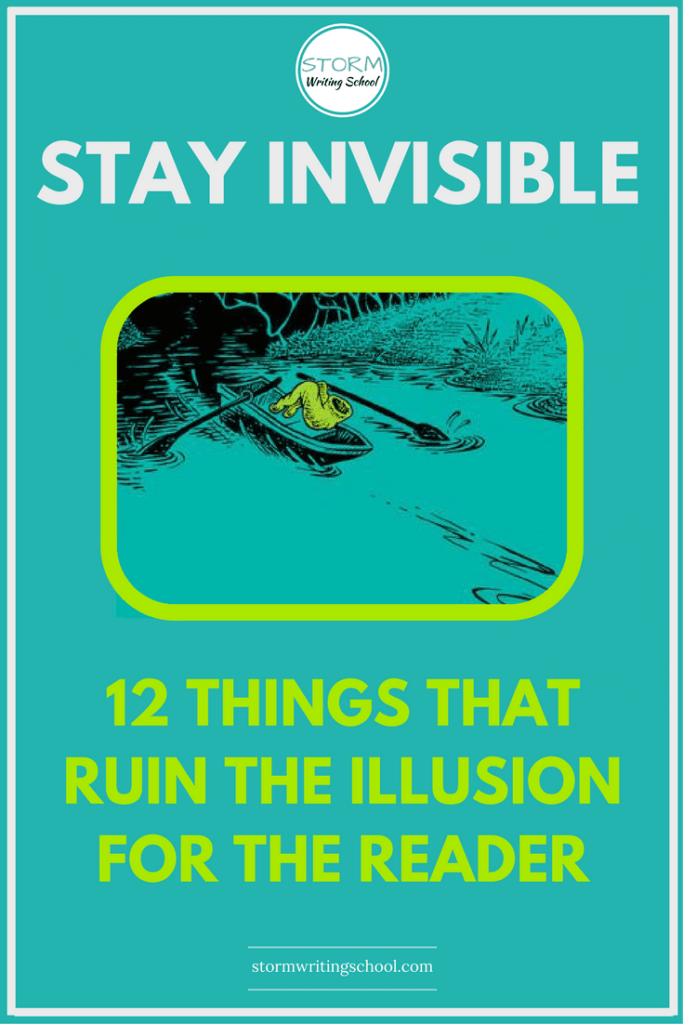
Pete Fromm, one of my mentors in my MFA program, was famous for his brutally insightful comments on student work. Among the many recurring annotations he made was one in which he labeled a line or character trait or event as “writerly.” If I had an overly coincidental act transform a character, he’d call that “writerly.” If I dropped in a gratuitous joke, he’d call it “writerly.” Though many of the things he singled out were fun to create—and therefore met with some initial defensive justification on my part—I came to see what he meant. He was identifying any place where it was clear that the story had been created by a writer. And he was pushing for an invisible writer.

Once the author becomes visible, the enchantment of the story dissolves. Cleverness is fun, but if it halts suspension of disbelief, then it’s not helping.
The author is the creator of a story, obviously, but the author should never be a part of the story. (Yes, never. My article on author, narrator, character might help clarify that assertion.)
The author is the man behind the curtain. Reveal that man and the narrative dies.
What sorts of things reveal the author?
1) Clichés
In his essay “On Fairy Stories,” JRR Tolkien explains that “things that are trite, or (in a bad sense) familiar, are the things that we have appropriated, legally or mentally. We say we know them. They have become like the things which once attracted us by their glitter, or their colour, or their shape, and we laid hands on them, and then locked them in our hoard, acquired them, and acquiring ceased to look at them.” When you use clichés of any variety, you risk getting the reader to ignore what you’re writing altogether, ceasing to look at it. That is, if your characters act or react in very familiar ways, we stop paying attention.
And worse, if we recognize that you’re telling the story in a clichéd manner, we’ll recognize that a story’s being told. I’m not just talking about cliché phrases like “dead as a doornail” or “steaming mad.” I’m talking about stock characters and typical stage business, or what Francine Prose calls, “shorthand for common psychic states.” “Writers cover pages with familiar reactions (her heart pounded, he wrung his hands) to familiar situations,” Prose says. This sort of thing:
When Marcy saw Tom, her heart beat wildly and her knees began to shake.
Cut it out. When you do that, the author is visible, and worse, the impression is that you’re a lazy author.
2) Pacing
When a scene moves too quickly or if you render a scene as summary rather than scene, we’ll feel we’re in the hands of an amateur. I admit to doing this in my rough drafts all the time. I write slowly and deliberately, so by the time I finish working on an intense scene, I’ve been there for hours. It feels long to me. But the scene may only be 200-300 words and may therefore end up feeling rushed. A capable author lingers on tension and wallows in it. If you speed past it, the reader will be on to you. It’s like being a good joke teller. Timing is everything in humor, right? Two people can tell the exact same joke, but the one with better timing will get more laughs. Brush up on scene vs. summary here.
3) Setup/Payoff
This is an offshoot of pacing, and there are lots of setup/payoff problems (one of the sections within my Story Momentum course is all about setup/payoff challenges), but one of the most common setup/payoff problems might be the deus ex machina coincidence. When you have a solution to a problem appear suddenly and without good cause, that’s deus ex machina. I like the Pixar rule about coincidence: “Coincidences to get characters into trouble are great; coincidences to get them out of it are cheating.”
The larger concept here may be about earning the events and reactions of your story. It’s fairly common for me to remark on manuscripts something along the lines of “I’d love for this reaction to be more earned.” When the events of a story feel false, you’ll come across as writerly.
4) Portraiture
A student of mine reminded me of this one and the next one, which might fall under the umbrella of self-gratifying digressions. Portraiture is when you deviate from the action and give us too much character description. There’s plenty of opportunity to describe characters (or to just imply character appearance) in the midst of story-relevant action. I think people have been taught to “show, don’t tell” so much that they feel that good writing all boils down to concrete descriptions. It’s not that concrete description isn’t important to writing. But it needs to be subservient to the larger goal of whatever it is you’re writing. If you’re telling a story, the description should serve the story (goal and conflict, in a nutshell). If you’re writing an essay, the description should serve the thesis/argument.
5) Overplaying
For those of us who are storytellers, you risk being writerly any time you stray from the story and get lost in the beauty of your own writing. The aforementioned student of mine dubbed this, “Too much playing on the page.” In addition to portraiture, when you meander too far into beautiful, poetic language or go overboard with describing the setting, you’re in writerly territory. (One of my pet peeves in manuscripts is long passages describing people eating food as a backdrop to dialogue.)
Back in my first semester of grad school, I was accused of occasionally going for the gag over the story. It’s not that you can’t be funny or that there isn’t a place for a line like this: “Don’t worry, though, he’s plenty sober now; he got into weight-lifting ‘the natural way’ and hangs out with a bunch of hairless orangutans with names like Rod and BJ.” It’s just that in my story, this was an aside about the brother of the main character’s girlfriend, a guy who plays absolutely no role in the story whatsoever. It was fun when I wrote it, that’s for sure. Heck, I still find it amusing. But it belongs somewhere else.
6) Telegraphing
An author who doesn’t trust the reader to figure things out feels the need to state what is already apparent. Telegraphing is when you tell us something before proceeding to show it. Here’s an example (with some cliche thrown in for good measure):
Monte did not mince his word. “Get out, you deplorable, fetid garbage heap!”
The announcement that Monte did not mince his words is telegraphing. It’s entirely unnecessary. When the author labels what the character is doing for us, that’s an unwelcome intrusion. If you announce, “Monte changed the subject,” and then proceed to show Monte changing the subject, you’re robbing the reader of the chance to read the subtext. Subtext is, by definition, not spelled out for us. Don’t ruin it.
7) Info dumps
One of the most common writerly mistakes I see, info dumps can occur in both narration and dialogue. Paragraphs of exposition, informing us of backstory or of world-building “facts,” will rip us from the narrative. (Alternate reality stories are probably the most guilty of narration info dumps. Writers of fantasy are especially prone to overplaying with the world-building.) But info dumps in dialogue are even more common. One former instructor of mine called these As-you-know-Bobs, as in, “As you know, Bob, the FTL drive takes at least two hours to warm up.” If Bob knows it, there’s probably no reason for anyone to tell him. The reader will see right through this very writerly method of informing us about the mechanisms animating the fictional universe. (See my previous article on handling information.)
8) Clumsy incorporation of interiority
I’ve already mentioned the problem that arises when thoughts feel unearned. But it’s not the only way to screw up interiority. Telling (vs. showing) is the most common type of clumsy interiority. But another one of my pet peeves is when thoughts are delivered via italicized, first-person present tense. Yes, some famous authors do it, and readers can get used to it, but it always feels writerly and unnecessary to me. (See my previous article on interiority for a few more tips on handling character thought and emotion and for the psychic distance solution to those italicized thoughts.)
9) Inconsistent tone
In narration, when you use language that doesn’t fit with the mentality of the perspective character, you’ll give readers pause. Or in dialogue, if you use language that the character wouldn’t use, you’ll also tear the curtain down and get us seeing the small man pretending to be the wizard.
10) Anachronism & Friends
Anachronism is about temporally-inappropriate inclusions, but we could broaden this to include anything incorporated in the world that doesn’t fit there. A sudden, one-off instance of magic 3/4s of the way through a realist novel; an iPhone in a story that takes place in the 90s; an inexperienced water-skier jumping over a shark.
11) Didactic moments
When we feel the writer is preaching to/at us, we’ll be ripped from the story. In fact, any time theme is visible, you’re in trouble. Theme, like subtext, should remain below the surface. You may think that writers of Children’s Literature could get away with being preachy? Nope. Here’s a nice observation from that article:
Think of the classic Where the Wild Things Are by Maurice Sendak. In that book, Max’s central story problem is anger: he’s got a temper, and he gets in trouble with his mother because of it. She sends him to his room, where he “escapes” by going to a fantasy jungle with wild beasts. He thinks this this is going to be great—but then he is frightened by the roaring and the wild action of the beasts. Sendak never says, “And so Max realized why getting angry was wrong, and went home and apologized to his mother.” Instead, Sendak simply shows Max fleeing back to his bedroom, where he is overjoyed to see that his mother has left a bowl of steaming soup for him. Without saying anything more, this is how Sendak shows that Max has overcome his anger. It’s all subtle: done more with suggestion than direct words. But it’s a superb model of how to reveal theme in a story, and it’s why the book is a classic.
12) Inconsistent character behavior
We already discussed character behavior being unearned, which is a setup/payoff problem. But there’s a larger umbrella of inconsistent character behavior. When it feels like characters are being manipulated (like puppets) rather than reacting in authentic ways, you’ll rip the reader from the story. See Game of Thrones, Seasons 7 and 8.
There’s an important caveat to all this:
You can’t write out of fear of what to avoid. You write (and do everything else you want to improve at, really) by striving after a goal, not by running from failure. Knowing what to avoid is helpful for editing, critiquing, and for revising. But set aside the critical and fearful mindset when you’re creating.SaveSaveSaveSaveSaveSaveSaveSaveSaveSaveSaveSave








13 Responses
Thanks Tim. I really enjoyed reading your article and will take these points into account with my novel. It has time travel in it, so I’ve given myself a bit of a challenge! Lots of research, etc.
This is some of the most helpful advice I’ve read.
I’ve wanted to write a book since I was 12, and now that I’m a grandmother I have the luxury of writing something with no concern for being published; I just want to prove to myself that I can write a book with consistent characters and a story that engages the reader.
I was an English major, a magazine editor, and I’m a voracious reader. All these things do not a good writer make. In addition, if writing is not the highest of priorities, it is unlikely that a book will ever be completed. So kudos to those who have actually written a book!
This is all to say thank you very much. I am now a fan of Storm Writing School.
Aw, thanks, Abby! Finishing a story and being happy with it is the most satisfying part of the whole process. Getting published can sometimes be a source of lots of stress. Best of luck with your story!
I read a lot of tracts on craft and the art of writing. It is rare I re-read, or read a third or fourth time for what I call the marrow. It’s not the use of big words; I adore words of a certain caliber… rather, calibre. It is not the fertile thoughts you convey; I enjoy new and depth-defying concepts. But when I find myself pondering a piece when I should be WIP’ing or revising, there must be eggs in need of cracking. A somewhat noisy way of saying thank you, and well done. C’nest pas?
Aw, thanks so much! I love noisy ways of saying thank you!
Clear, helpful information, as usual. Thanks Tim.
Thanks, Christine!